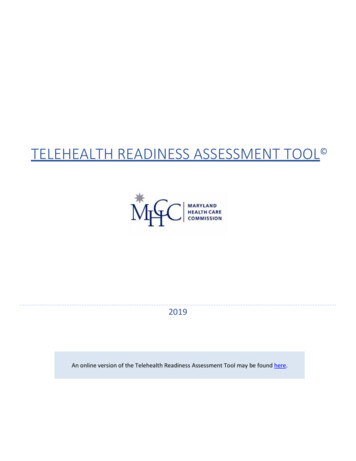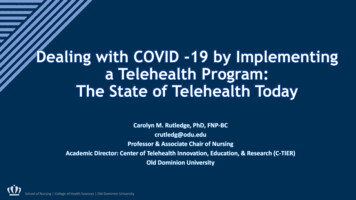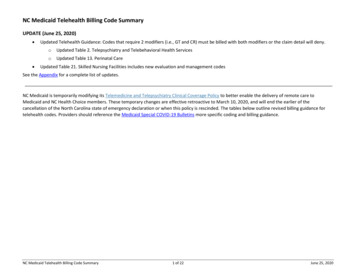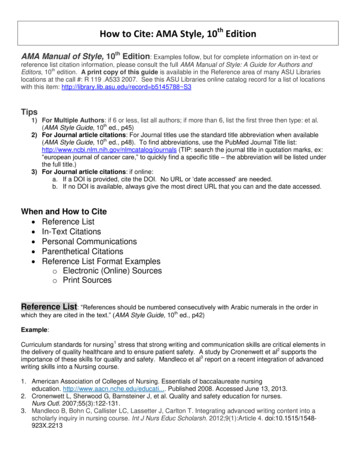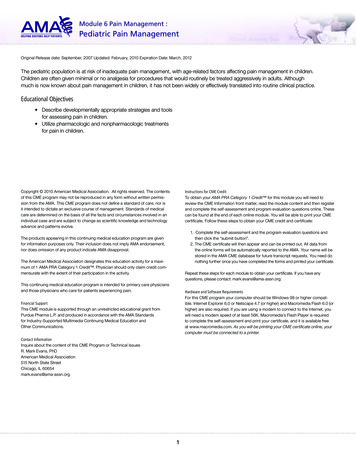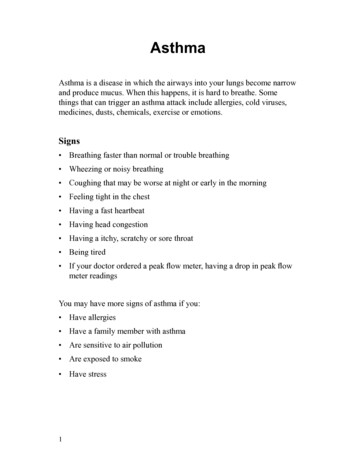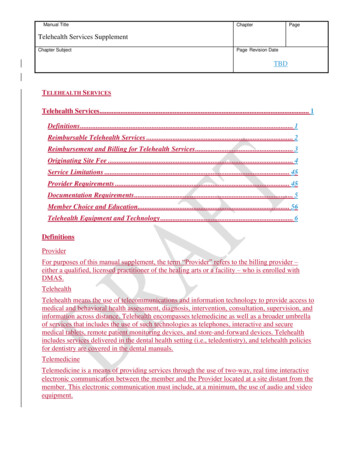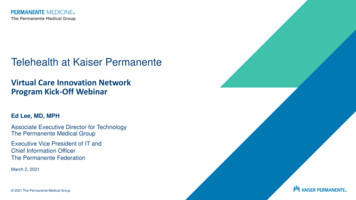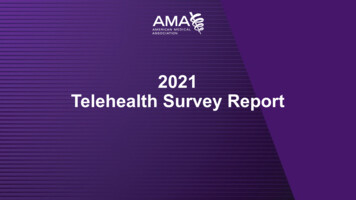
Transcription
2021Telehealth Survey Report1
AMA Telehealth SurveySurvey summary: This survey of physicians aimed to gather insights on the experiences of currentand expected future use to inform ongoing telehealth research and advocacy, resourcedevelopment, and continued support for physicians, practices, and health systems.Data collection: The anonymous online survey was distributed to a convenience sample via emailand social media by individuals, state and specialty medical organizations, and members of theAmerican Medical Association Telehealth Immersion Program. The survey was active for 8 weeksbetween November 1, 2021, through December 31, 2021. Responses described in this reportrepresent 2,232 physician participants. Due to small sample size, responses from otherparticipants, including nurses, physician assistants, and other practitioners, are not included.Report limitations and considerations: The data presented in this report is based on a nonprobability convenience sample. Results should be considered directional and are not intended tosuggest statistical significance or applicability to the general U.S. physician and healthcareprofessional population.Note: Trend comparisons made to 2020 data refer to the COVID-19 Healthcare Coalition Physician Survey2 2022 American Medical Association. All rights reserved.
Telehealth Use TrendsCLINICAL OUTCOMESPATIENT EXPERIENCE85% of physician respondents indicate they currently usetelehealth. For those that report a decrease in use indicatenow doing a mix of in-person and virtual care. More than 80% of respondents ( 12%)indicate patients have better access to caresince using telehealth. 60% of clinicians agree or strongly agree telehealthenabled them to provide high quality care. 62% of respondents feel patients have highersatisfaction since offering telehealth. Of those using telehealth, 93% ( 13%) are conductinglive, interactive video visits with patients and69% are doing audio-only visits. 56% of respondents are motivated (agree and stronglyagree) to increase telehealth use in their practices.63% ( 12.2%) of respondents report 75%or more of virtual visits are conducted withpatients they have an existing relationshipwith. 8% ( 4%) of respondents said they were usingremote patient monitoring technologies with patients intheir homes; the commonly used tools includesmartphones (camera), blood pressure cuffs, pulseoximeters, and body weight scales. 76% ( 7.6%)report data is usually shared manually (e.g. verballyover the phone or via email).Note: Trend comparisons refer to the COVID-19 Healthcare Coalition Physician Survey fielded in 2020.3 2022 American Medical Association. All rights reserved.PROFESSIONAL SATISFACTION A majority of respondents indicated thattelehealth has improved the satisfaction oftheir work 54.2%.COST 44% of respondents indicated that telehealthdecreased the costs of care (strongly agreeor agree)
Telehealth use4 2022 American Medical Association. All rights reserved.
85% of respondents report using telehealthDo you currently use telehealth to care foryour patients?If not, did you provide telehealth at any pointduring the COVID-19 pandemic?No15%No57%Yes85%Do you currently use telehealth to care for your patients? N 2,149Did you provide telehealth at any point during the COVID-19 pandemic? N 3125 2022 American Medical Association. All rights reserved.Yes43%
Most respondents that report a decrease in use nowprovide a mix of in-person and virtual careHas your use of telehealth decreasedsince you first offered telehealth?If your telehealth use has decreased, why?0200400600I’m doing a mix of in-person and telehealth visits562Patients prefer to come in-person468I prefer to provide care in-person331Most of my patient popula tion experiences technology barriers including limitedacc ess to devic es or limited digital litera cyNo48%Yes52%218I don’t think telehealth is appropriate for my specialty.142The geographic loca tion of my practic e or pa tients has broa dband internetlimita tionsPrivacy concernsOtherHas your use of telehealth decreased since you first offered telehealth services? N 1,705If your telehealth use has decreased, why? N 8796 2022 American Medical Association. All rights reserved.8516198
The percent of telehealth compared to in-personvisits varies across physicians and practices46.8% of respondents60048550021.3% of respondentsFrequency40031030020032530.6% of verage percent of patient visits in a week delivered via telehealthOn average, how many patient visits do you have per week, including in-person and telehealth?How many telehealth visits do you currently average per week?7 2022 American Medical Association. All rights reserved.N 1,698
63% of respondents indicate 75% or more oftelehealth visits are with established patients120063%100080060040016%20013%8%00 to 25%26 to 50%51 to 75%More than 75%Currently, based on total volume of telehealth services delivered, what percent of your telehealth visits are with patientswith whom you have an established patient/physician relationship?8 2022 American Medical Association. All rights reserved.N 1,724
Where are physicians and patients located during thevirtual visit?Physicians are typically located in the clinic or homePatients are typically located in their homeTheir homeClinic95%80%OtherMy home26%64%Another clinic/distant siteHospital11%15%HospitalOther7%0200I don’t know4006008001000120014001600From where have you conducted your telehealth visits? (select all that apply) N 1,678Frequently reported “Other” locations: Office 7799% 2022 American Medical Association. All rights reserved.2%02004006008001000120014001600Where are your patients during their telehealth visits?(select all that apply) N 1,672Frequently reported “Other” locations: Work 235; Car 218; School 381800
A deeper dive into thetelehealth experience10 2022 American Medical Association. All rights reserved.
Telehealth is currently being used across many aspectsof clinical care and used to deliver a variety of services03006009001200015002004006008001000Medical management (e.g. medication man agement)Treatment or therapy72%77%Chronic disease managementScreening, assessments, or diagnosis72%68%Specialty care49%Mental/b ehavioral healthFollow up care (e.g., post-surgical, Chroniccare, Post Hospitalization)44%70%Continuous monitoring53%Intake or triageAcute care u rgent care/same day37%Preventative care or Primary Care37%Care coordin ation36%41%Hosp ital or ED follow-up careOtherNone of the above10%Other0.2%What aspects of care do you provide via telehealth? (select all that apply) N 1,682 2022 American Medical Association. All rights reserved.33%Acute care inpatientNon e of the above11120013%5%0.4%What services do you or your practice/organization currently provide via telehealth? N 1,630
Physician SentimentsPhysicians shared a variety of specific use casesfor telehealth across practices and specialtiesManagement ofseizure disordersincluding aines &HeadachesSubstance UseDisorderStrokeCareADHDWhat specific use cases within your specialty do you find most appropriate for telehealth? 2022 American Medical Association. All rights sureManagement
Physician SentimentsMost physicians feel telehealth allows themto provide more comprehensive quality careTelehealth has allowed our practice to provide more comprehensive qualitycare for patients50031.3%45028.6%40024.2%350“As a pediatrician, it gives me an opportunity to seechildren and their families in a setting (home) in whichthey feel comfortable, and this sometimes revealsstrengths of the family.”“At-home blood pressuremonitoring has enabled us todiagnose more white coat andmasked hypertension”30025020011.1%1501004.8%500Strongly disagreeDisagreeNeutralAgreeStrongly AgreeTo what extent do you agree or disagree with the following statements? Telehealth has allowed our practice to provide more comprehensive quality care for patients. N 1,393Is there any additional insight or thoughts you would like to share regarding the impact of telehealth on you, your practice, or your organization?13 2022 American Medical Association. All rights reserved.
Physician SentimentsTelehealth offers access to care and conveniencethat contributes to improved patient satisfaction 80% agree or strongly agree patients have better access tocare since they began using telehealth60038.5%41.7%62% of physicians agree or strongly agree theirpatients are more satisfied since using 0010020012.3%2003.1%150500Strongly disagreeDisagree6.5%1004.5%NeutralAgreeStrongly Agree“Telehealth increased access for our specialty care. Reducing 7rst visitsto under 4-5 days compared to 4-5 months.”2.9%0Strongly disagreeDisagreeNeutral 2022 American Medical Association. All rights reserved.Strongly Agree“Telehealth has been great for my patients with disabilities thatimpact their mobility. Transportation is a challenge for them, and Ican see how they interact with their home environment, which iscrucial for my job.”To what extent do you agree or disagree with the following statements? Patients have better access to care since our practice began using telehealth. N 1,402To what extent do you agree or disagree with the following statements? Patients have higher satisfaction since our practice began using telehealth. N 1,392Is there any additional insight or thoughts you would like to share regarding the impact of telehealth on you, your practice, or your organization?14Agree
Physician SentimentsTelehealth has increased professional satisfactionOver 50% of physicians indicate telehealth has increasedtheir professional satisfaction“I am a wife, mother, and in a dual physician partnership, andtelehealth allows me to balance my professional and familyobligations without leaving my profession for family reasons in themiddle of my �The option of providing care via telehealth has increased myprofessional satisfaction and actually has delayed my decision toretire in a time when many in our 7eld are retiring prematurely andexacerbating the physician shortage.”1509.0%100500Strongly disagreeDisagreeNeutralIs there any additional insight or thoughts you would like to share regarding the impact of telehealth on you, your practice, or your organization?To what extent do you agree or disagree with the following statements? Telehealth has increased my professional satisfaction. N 1,40015 2022 American Medical Association. All rights reserved.AgreeStrongly Agree
Physician SentimentsTelehealth has had a positive impact on cost of care, butinvestment is still needed to continue the move towardsdigitally enabled 25.1%35063% of physicians feel most of the telehealth visitsthey provide supplement in-person care.65% of physicians feel most of the telehealth visitsthey provide replace care delivered in-personTelehealth has decreased the cost of greeDisagreeTo what extent do you agree or disagree with the following statements? Telehealth has decreased the cost of care. N 1337To what extent do you agree or disagree with the following statements? Most of the virtual telehealth visits I provide replaces in-person care. N 1,401To what extent do you agree or disagree with the following statements? Most of the virtual telehealth visits I provide supplements in-person care. N 1,36016 2022 American Medical Association. All rights reserved.NeutralAgreeStronglyAgree
Most practices are measuring the value oftelehealth via patient satisfaction and access tocare metrics0100200300400500600700800Patient satisfaction786Access to care746Clinical outcomes and clinical quality528Practice/operational efficiency and effectiveness498Clinician experience482Reimbursement/Payment445Cost saving262Health equity233We currently do not measure the value of telehealthOther50893How do you currently measure the value of telehealth in your practice or organization? N 1,55817 2022 American Medical Association. All rights reserved.
Most are focused on sustaining telehealth at theirpractice or organizations1200Implementation just getting startedin implementing telehealth69%1000Optimization looking to improveexisting telehealth operations800Sustainability interested incontinuing to offer telehealth servicesthat seamlessly integrate with inperson care37%60026%4002007%5%0Implementati onOptimizationSustainabilityExpansionAt what stage is your organization's telehealth program? (select all that apply) N 1,58518 2022 American Medical Association. All rights reserved.OtherExpansion looking to expandtelehealth offerings for other services,additional locations, or morecomprehensive virtual care
Future plansLooking ahead, organizations are interested incontinuing to offer telehealth and increase useI am personally motivated to increase use of telehealth in mypracticeMy organization’s leadership is motivated to continue use oftelehealth in my 0505006.6%3.7%0Strongly disagreeDisagreeNeutralAgreeStrongly AgreeStrongly disagreeDisagreeNeutralAgreeStrongly AgreeTo what extent do you agree or disagree with the following statements? I am personally motivated to increase use of telehealth in my practice. N 1,401To what extent do you agree or disagree with the following statements? My organization’s leadership is motivated to continue use of telehealth in my practice. N 1,32219 2022 American Medical Association. All rights reserved.
Future plansPractices plan to offer a variety of services viatelehealth in the future for a variety of reasons050001000Medical management973Chronic disease management918Mental/behavioral health200400600800 1000 1200 1400Reduce patient barriers to access care1364Reduce unnecessary patient costs (travel , time offwork, etc.)1282694Increase patient satisfacti onSpecialty care649Care coordination633Preventive care or primary Care546Acute care urgent care/same day524Hospital or ED fol low-up care516Acute care inpatientOther (please specify)We plan to decrease or eliminate telehealth offeringsNone of the above2221301107Virtual care has been clinically effective1070Virtual care has prov en to be operationally effective1001Increase professional sati sfaction653Provide more comprehensive care520Other18388134I’m not interested in con[nuing telehealth85What telehealth services does your practice or organization plan to offer in the future? (select all that apply) N 1,599Which of the following are reasons why you are interested in continuing to provide care via telehealth? (select all that apply) N 1,59120 2022 American Medical Association. All rights reserved.
A closer look at technology 21 2022 American Medical Association. All rights reserved.
Most physicians use live audio-visual andtelephone/audio-only technology to deliver telehealthLive audio-visual interac[ve telehealth visits93%Telephone/audio-only call s with patients69%Asynchronous telehealth12%Remote patient monitoring of a patient8%Other telehealth3%None of the above0%020040060080010001200140016001800Which of the following telehealth modalities do you currently use to provide clinical care virtually to patients? (select all that apply) N 1,66822 2022 American Medical Association. All rights reserved.
Telephone and Zoom remain the primary platforms used todeliver virtual care; most access some or all via the EHRTelehealth Platforms Used0200400600800Audio-only telephone vi sits723Zoom600Doximi ty Video439EHR teleheal th module or tools433Doxy.me344Telehealth vendor340FaceTime8%45%234Microsoft Teams92Texting89Skype48Remote patient monitoring tools46Asynchronous messaging app43%30Other1196*Other platforms mentioned in free text (in order of frequency) include: AmWell, Epic, Google (Duo or Meet),UpDox, WebEx, Teledoc, Bluejeans, eClinicalWorks, and a variety of other system unique platforms.Which platform(s) do you use to deliver telehealth services? (select all that apply) N 1,657Are you able to access your telehealth technology directly from your Electronic Health Record (EHR)? N 1,65623 2022 American Medical Association. All rights reserved.4%269Patient PortalNone of the aboveAre you able to access technologydirectly from your EHR?YesNoSomeI do not know
Technology used to augmenttelehealth services0500Smartp hone camera photos207Body weight scale199Thermometer166Smartp hone microphone audio recordings (e.g., to record patientsymptoms, docu ment visits, etc.)158Heart rate monitor58Portable EK G32Home s pirometer2676%111804NoWhat type of technology are you using to support/augment your telehealth services? (Select all that apply) N 1,647Do the devices you selected in the previous question automatically collect and deliver patient reported data to you? N 842 2022 American Medical Association. All rights reserved.15%91Yes242%105Con tinu ous glucos e monitorNon e of the above7%297Pulse oximeterOther1000550Blood pressure cuffsActivity monitorsOver 75% report data fromsupport technology is notautomatically transmittedSomeI do not know
Barriers and challenges25 2022 American Medical Association. All rights reserved.
Physician SentimentsPhysicians identify the digital divide as thebiggest barrier to virtual care for patients05001000Limited patient access to technology954Limited digital literacy in patient mix829Limited patient access to broadband internet757Patien t preferen ces for in-person vis its683Limited patient access to data access th rough their cellularplanLimited patient awareness or understanding of insurancecoverage for telehealth429331Patien t awaren es s of telehealth offerings“Many of my patients are not that well versed intechnology and telehealth is a real big challenge forthem.”319Lack of access to langu age/interpretation services294Lack of in suran ce266No barriers known121All of the above109Limited access to community-based resources102Other“Reduce the digital divide that impairs many patients'access to telehealth services.”“Advancing telehealth without providing patients withthe appropriate technology or education to use it,leaves those patients behind and widens the gaps.”52Which of the following, if any, do you perceive as barriers to your patients using telehealth? (select all that apply) N 1,531Is there any additional insight or thoughts you would like to share regarding the impact of telehealth on you, your practice, or your organization?26 2022 American Medical Association. All rights reserved.
Physician SentimentsBarriers to offering telehealth include coverage,payment, and reimbursement uncertainty02004006008001000Roll back of COVID-19 waivers, coverage, and payment polici es1171, 76%Low or no reimbursement992, 64%Technology challenges for my pat ient population829, 54%Licensure in additi onal states623, 40%Liability444, 29%Integration with the EHR335, 22%Lack of technical support319, 21%Telehealth-specific workflows277, 18%Integration of additional technologies273, 18%Lack of guidelines for clinical appropriateness in telehealth238, 15%Low patient engagement203, 13%Clinician dissatisfaction/lack of buy-in192, 12%Cost of implementing or maintaining telehealth platform189, 12%Little or no buy-in from administrators or leadershipI do not anticipate any barriers or chall engesOther14001182, 77%Lack of insurer coverage of telehealth servicesLack of marketing for telehealth services1200124, 8%101, 7%85, 6%57, 4%Which of the following, if any, do you anticipate being ongoing barriers or challenges to your organization offering telehealth? (select all that apply) N 1,54527 2022 American Medical Association. All rights reserved.
Physician SentimentsPhysicians advocate strongly for audio-onlyand permanent payment coverage“I worry about telephone visits no longerbeing covered! They are a large part of thecare that we can provide to our patients,who have limited access to other digitaltechnology, Wi-Fi, etc.”“It’s incredibly important for audioonly/telephone calls to remain anoption to minimize barriers for patientswith low resources.”“Both audio-only and video visits must continue to be reimbursedand done so at the same level as of7ce visits. I provide the samecare either way, so reimbursement should be the same. If I feel Ican't treat someone appropriately via Telehealth, I instruct them tocome into the of7ce.”“Payment parity is critical for telephoneonly encounters. Patients should not bepenalized for access to care if they do nothave the technology or cannot easilyaccess care.”Is there any additional insight or thoughts you would like to share regarding the impact of telehealth on you, your practice, or your organization?28 2022 American Medical Association. All rights reserved.
Physician SentimentsPhysicians identify the following as opportunities toimprove telehealth workflows in the practice020406080100120140160180Separate schedule blocks for in-person visits and telehealth visits186A formal process for patient check-in and check-out171Additional staffing resources to support workflows159Telehealth-specific training for other members of the care team152Technology that provides a digital waiting room151Better office/exam room space to facilitate telehealth visitsOther9632Which of the below would support improved telehealth-specific workflows? (select all that apply) N 27629 2022 American Medical Association. All rights reserved.200
In summary 30 2022 American Medical Association. All rights reserved.
Key findings and implications1. Physician interest in continuing to use telehealth in the future remains strong. 85% of physician respondents indicate they are currently using telehealth to care for patients. Nearly 70% of physician respondents report their organization is motivated to continue using telehealth in their practice. Many physicians foresee providing telehealth services for chronic disease management and ongoing medicalmanagement, care coordination, mental/behavioral health, and specialty care.Providing support and guidance in these areas would help physicians prepare for success as they expand telehealth services.2. Lack of insurance coverage and little to no payer reimbursement persist as barriers to implementing and continuing telehealthservices. Payers, both public and private, should continue to evaluate and improve policies, coverage, and reimbursement ratesfor services provided via telehealth. The majority of physician respondents indicate they anticipate low or no reimbursement to be a primary barrier orchallenge to their organization offering telehealth in the future.Physicians advocate strongly that telehealth via audio-only/telephone remains covered in the future to ensure equitable access.3. Less than half of respondents report being able to access their telehealth platform via their EHR and more than 75% report thattheir support technology does not automatically collect and deliver patient reported data.Improving interoperability between platforms and support technology would help improve and streamline telehealth services.31 2022 American Medical Association. All rights reserved.
Key findings and implications4. 95% of physicians report patients are primarily located at their home at the time of the virtual visit.Allowing patients to be in their home is a key component of making telehealth more accessible and convenient. This supports the Telehealth Modernization Act of 2021 and CONNECT for Health Act which would lift the rural-onlyrestrictions and add home as an originating site.5. Physicians perceive technology, digital literacy, and broadband internet access to be the top 3 patient barriers to usingtelehealth.The AMA will advocate for equitable access for under-resourced patient populations and communities, including but not limitedto, supporting increased funding and planning for telehealth infrastructure such as broadband and internet-connected devices This supports AMA policy D-480.963.6. Our findings suggest physicians may learn from additional research on the impact of telehealth on: EquityQualityCostsPatient satisfaction Disparities in reimbursementBest practicesImplementation scienceClinical appropriatenessThe AMA will continue to expand its research with partners to help broaden the field of knowledge in these areas andencourages other stakeholders to invest in research and development of best practices.32 2022 American Medical Association. All rights reserved.
Appendix34 2022 American Medical Association. All rights reserved.
PhysiciansampleN 2,232 Physicians (MD/DO)SpecialtyAllergy / ImmunologyAnesthesiologyCardiologyThoracicSurgery CardiovascularDiseases Critical CareDentistry / Oral SurgeryDermatologyEmergency MedicineEndocrinologyFamily MedicineGastroenterologyGeneral PracticeHematology / OncologyHospitalistInfectious DiseaseInternal Medicine, Primary CareMental/Behavioral HealthNephrologyNeurological SurgeryNeurologyObstetrics and GynecologyOncologyWhich of the following best describes you?Please indicate which of the following best describes your specialty.35 2022 American Medical Association. All rights 167708SpecialtyOphthalmologyOrthopedic SurgeryOtolaryngologyPalliative CarePathologyPediatrics – Primary CarePediatrics – HospitalistPediatrics – Procedural specialtiesPediatrics – CognitivePhysical Medicine and RehabilitationPlastic SurgeryPsychiatryPulmonary DiseaseRadiation OncologyRadiologyRheumatologySurgery, GeneralUrological SurgeryVascular SurgeryOther surgery-related specialtyOther non-surgery-related specialtyN/ATotal N N263121751114121719992802116211920115155182,232
Practice AttributesPractice TypePractice Setting0200400Physician’s ofDce, single specialty group practiceUrban45%Suburban43%407Hospital, teaching362Multi-specialty group practice or clinic351Physician’s office, solo practice315Hospital, non-tea chingDirect to consumer telehealth companyRural12%UrbanRuralSuburbanIn what setting is your main/primary practice located? N 1,694Which of the following best describes your main practice? N 1,68836 2022 American Medical Association. All rights reserved.7421Skilled nursing facility12Urgent care facility10Home health agencyOther (please specify)6005131
State (residence)5953115104043 29271112443217125633 2017501893Puerto Rico – 11U.S. Virgin Islands - 2Please indicate the state in which you reside.37 2022 American Medical Association. All rights reserved.Powered by Bing GeoNames, Microsoft, TomTom
State (licensed to practice)9221442719671913 288837126622152274089351512527Please indicate the state(s) in which you are licensed to practice medicine. N 2,298 2022 American Medical Association. All rights reserved.13469583838236107Puerto Rico – 14U.S. Virgin Islands - 5Powered by Bing GeoNames, Microso:, TomTom
bi nary/third gender40%53%GenderqueerPrefer to self-describeAgeAge GroupN%18 to 3070.4%31 to 4022513%41 to 5032219%51 to 6456533%65 or older47528%Prefer not to answer976%Prefer not to answerRace/Ethnicity3%3%2%0%White/CaucasionPrefer not to answer4%Asian/Pacific Islander11%Two or moreBlack/African American11%66%Hispanic/LatinxOtherPlease indicate your age. N 1,691Please specify your gender. N 1,692Please indicate your race/ethnicity (select all that apply). N 1,69339 2022 American Medical Association. All rights reserved.Native American or AmericanIndian
Practice AttributesPayers AcceptedPayment ModelsNone of the above42%Private / Commercial Payer86%MedicareAccountable Care Organization79%27%MedicaidPatient Centered Medical Home73%13%Veterans AffairsAlternative Payment Model Bundled Models6%OtherFree Care4%Other Alternative Payment or Advanced APM10034%None of the above6%Not sure3%041%2003004005006007008004%0200400Please indicate if you participate in any value-based care models or payment arrangements. (select all that apply) N 1,685Which of the following payers do you accept in your practice? (select all that apply) N 1,67940 2022 American Medical Association. All rights reserved.6008001000120014001600
Physician SentimentsPhysicians feel telehealth enables them to providehigh-quality care for many types of services8007006005004003002001000Ac ute care inpatientAc ute care urgentcare / same dayChronic diseasemana gementPreventive care orprimary ca reHospital or ED followup ca reStrongly disagreeDisagreeCare c oordinationNeutralAgreeMedic al managementMental / behavioralhealthSpecialty careStrongly AgreeTo what extent do you agree or disagree with the following statement: Telehealth enables me to deliver high-quality care for N 1,45341 2022 American Medical Association. All rights reserved.Other
Live audio-visual technology ispredominately used to see patients at homeRemote patient monitoring is mostly usedto see a patients at home95.1%For a patient at homeFor a pati ent who is at home89.8%15.8%For a patient in an outpatient clin icFor a pati ent who is at anot her distant site13.7%For a patient in a post-acute s etting (SNF, LTAC, Home Health etc.)10.6%For a hospitalized patient in acu te settin g (patient in hospital ward, ICU, or longterm care s etting)8.2%For a patient at a school or ch ildcare facility5.3%For a patient in the emergency department050010001500For a pati ent who is at anot her acu
To what extent do you agree or disagree with the following statements? Telehealth has increased my professional satisfaction. N 1,400 Over 50% of physicians indicate telehealth has increased their professional satisfaction "The option of providing care via telehealth has increased my professional satisfaction and actually has delayed my .
